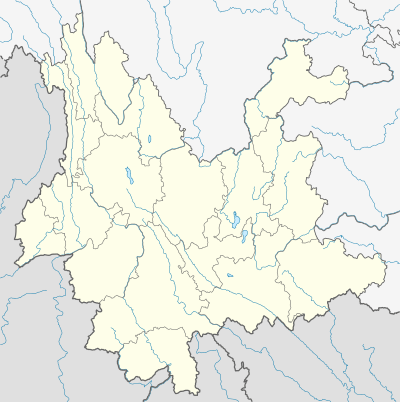Wuding County
Wuding County (Chinese: 武定县; pinyin: Wǔdìng Xiàn) is under the administration of the Chuxiong Yi Autonomous Prefecture, in the north-central part of Yunnan province, China, bordering Sichuan province to the north.
Wuding County 武定县 | |
|---|---|
 Wuding Location of the seat in Yunnan | |
| Coordinates: 25°31′48″N 102°24′14″E | |
| Country | People's Republic of China |
| Province | Yunnan |
| Autonomous prefecture | Chuxiong |
| Area | |
| • Total | 3,322 km2 (1,283 sq mi) |
| Population | |
| • Total | 260,000 |
| • Density | 78/km2 (200/sq mi) |
| Time zone | UTC+8 (CST) |
| Postal code | 651600 |
| Area code(s) | 0878 |
| Website | www |
Ethnic groups
Yi
The Wuding County Almanac (1990) lists the following Yi subgroups.
- Nasu 纳苏 / Black Yi 黑彝
- Naluo 纳罗 / Gan Yi 甘彝
- Naisu 乃苏 / Red Yi 红彝
- Miqie 密切 / Micha 密岔
- Luoluo 罗罗 / White Yi 白彝
- Sani 撒尼 / Minglang 明郎
Hani
In Wuding County, ethnic Hani are found in the following locations (Wuding County Almanac 1990:141).
- Chayiyang 扯衣咩村,[1] Ande Township 安得乡, Chadian District 插甸区
- Lower Village 下村[2] and Azhemi 阿者咪村[3] of Dacun Township 大村乡
- Zhong 中村,[4] Xia 下村, Yangliuhe 杨柳河,[5] and Aozi 凹子[6] of Huaqiao Township 花乔乡
- Shedian Village 赊甸村,[7][8][9] Laotao Township 老滔乡
According to the Chuxiong Prefecture Almanac (1993:411), the Luomian 罗缅, a Hani subgroup, are located in Nigagu 尼嘎古.[10]
Languages
Gao (2017)[11] lists the following languages of Wuding County. Gao (2017) classifies Geipo of Wuding County as closely related to Miqie, and is not the same as the Northern Loloish language Gepo.
| Group | Autonym | Language classification | Population |
|---|---|---|---|
| Nasu | na³³su³³ pʰo³³ | Ngwi, Northern | 28,000 |
| Aluo | a⁵⁵lu³³ pʰu⁵⁵ | Ngwi, Northern | 13,500 |
| Naisu | ne⁵⁵su³³ pʰo⁵⁵ | Ngwi, Northern | 6,000 |
| Lipo | li³³ pʰo²¹ | Ngwi, Central | 31,000 |
| Miqie | mi⁵⁵tɕʰi³¹ pʰo³¹ | Ngwi, Central | 9,000 |
| Lolo | lo³³lo³³ pʰo²¹ | Ngwi, Central | 8,500 |
| Geipo | ke⁵⁵ pʰo³¹ | Ngwi, Central | 350 |
| Hani | xo²¹ȵi²¹ pʰɑ²¹ | Ngwi, Southern | 800 |
| Ahmao | a³⁵hmo³³ kləu³¹ | Hmong, Chuanqiandian Dongdianbei | 21,000 |
| Hmong | mɛŋ⁴⁴ kləu⁵³ | Hmong, Chuanqiandian proper | 3,000 |
| Tai | tai⁵⁵ | Tai Hongjin, Yongwu | 8,000 |
Climate
| Climate data for Wuding (1981−2010) | |||||||||||||
|---|---|---|---|---|---|---|---|---|---|---|---|---|---|
| Month | Jan | Feb | Mar | Apr | May | Jun | Jul | Aug | Sep | Oct | Nov | Dec | Year |
| Record high °C (°F) | 24.5 (76.1) |
26.1 (79.0) |
29.2 (84.6) |
32.4 (90.3) |
32.8 (91.0) |
31.6 (88.9) |
32.7 (90.9) |
31.3 (88.3) |
31.7 (89.1) |
28.6 (83.5) |
25.7 (78.3) |
22.6 (72.7) |
32.8 (91.0) |
| Average high °C (°F) | 16.7 (62.1) |
19.2 (66.6) |
22.5 (72.5) |
25.7 (78.3) |
26.3 (79.3) |
26.0 (78.8) |
25.9 (78.6) |
26.2 (79.2) |
24.7 (76.5) |
22.4 (72.3) |
19.1 (66.4) |
16.2 (61.2) |
22.6 (72.7) |
| Daily mean °C (°F) | 7.3 (45.1) |
9.4 (48.9) |
12.8 (55.0) |
16.8 (62.2) |
19.9 (67.8) |
21.0 (69.8) |
20.7 (69.3) |
20.2 (68.4) |
18.8 (65.8) |
16.3 (61.3) |
11.6 (52.9) |
7.7 (45.9) |
15.2 (59.4) |
| Average low °C (°F) | 0.3 (32.5) |
1.5 (34.7) |
4.3 (39.7) |
8.7 (47.7) |
14.3 (57.7) |
17.3 (63.1) |
17.5 (63.5) |
16.7 (62.1) |
15.4 (59.7) |
12.7 (54.9) |
6.6 (43.9) |
1.8 (35.2) |
9.8 (49.6) |
| Record low °C (°F) | −7.0 (19.4) |
−5.0 (23.0) |
−3.5 (25.7) |
0.7 (33.3) |
5.1 (41.2) |
10.2 (50.4) |
11.8 (53.2) |
10.3 (50.5) |
6.1 (43.0) |
4.4 (39.9) |
−2.2 (28.0) |
−6.4 (20.5) |
−7.0 (19.4) |
| Average precipitation mm (inches) | 15.0 (0.59) |
12.9 (0.51) |
15.3 (0.60) |
25.2 (0.99) |
85.1 (3.35) |
188.2 (7.41) |
198.2 (7.80) |
163.9 (6.45) |
122.0 (4.80) |
94.5 (3.72) |
34.7 (1.37) |
12.1 (0.48) |
967.1 (38.07) |
| Average relative humidity (%) | 73 | 66 | 63 | 60 | 66 | 79 | 84 | 84 | 82 | 81 | 79 | 78 | 75 |
| Source: China Meteorological Data Service Center | |||||||||||||
gollark: So copy-cat with potatoS?
gollark: JS is inevitable. Atwood is coming for you.
gollark: I'm looking at making PotatOS for x86™ images.
gollark: Oh, so it's JavaScript.
gollark: oh no.
References
- "武定县插甸镇安德村委会扯衣咩". Ynszxc.gov.cn. Retrieved 15 August 2018.
- "武定县高桥镇大村村委会下村". Ynszxc.gov.cn. Retrieved 15 August 2018.
- "武定县高桥镇大村村委会阿者咪". Ynszxc.gov.cn. Retrieved 15 August 2018.
- "武定县高桥镇海子村委会中村". Ynszxc.gov.cn. Retrieved 15 August 2018.
- "武定县高桥镇花乔村委会杨柳河". Ynszxc.gov.cn. Retrieved 15 August 2018.
- "武定县高桥镇勒外村委会凹子". Ynszxc.gov.cn. Retrieved 15 August 2018.
- "武定县高桥镇老滔村委会赊甸大村". Ynszxc.gov.cn. Retrieved 15 August 2018.
- "武定县高桥镇老滔村委会赊甸中村". Ynszxc.gov.cn. Retrieved 15 August 2018.
- "武定县高桥镇老滔村委会赊甸小村". Ynszxc.gov.cn. Retrieved 15 August 2018.
- "武定县高桥镇尼嘎古村委会". Ynszxc.gov.cn. Retrieved 15 August 2018.
- Gao, Katie B. 2017. Dynamics of Language Contact in China: Ethnolinguistic Diversity and Variation in Yunnan. PhD Dissertation: University of Hawai‘i at Mānoa.
This article is issued from Wikipedia. The text is licensed under Creative Commons - Attribution - Sharealike. Additional terms may apply for the media files.